MERCEDES-BENZ SPRINTER 2006 Service Manual
Manufacturer: MERCEDES-BENZ, Model Year: 2006, Model line: SPRINTER, Model: MERCEDES-BENZ SPRINTER 2006Pages: 2305, PDF Size: 48.12 MB
Page 2271 of 2305
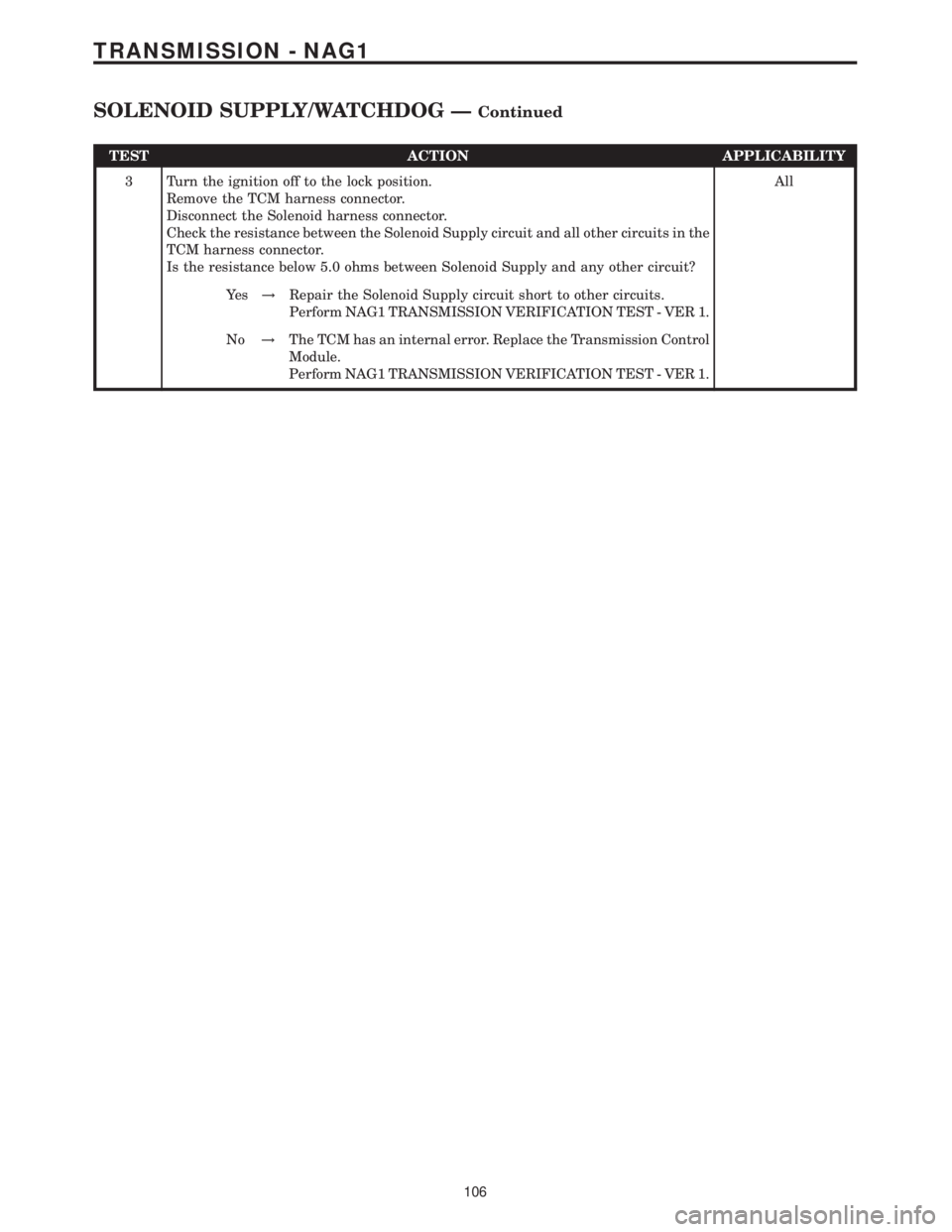
TEST ACTION APPLICABILITY
3 Turn the ignition off to the lock position.
Remove the TCM harness connector.
Disconnect the Solenoid harness connector.
Check the resistance between the Solenoid Supply circuit and all other circuits in the
TCM harness connector.
Is the resistance below 5.0 ohms between Solenoid Supply and any other circuit?All
Ye s!Repair the Solenoid Supply circuit short to other circuits.
Perform NAG1 TRANSMISSION VERIFICATION TEST - VER 1.
No!The TCM has an internal error. Replace the Transmission Control
Module.
Perform NAG1 TRANSMISSION VERIFICATION TEST - VER 1.
106
TRANSMISSION - NAG1
SOLENOID SUPPLY/WATCHDOG ÐContinued
Page 2272 of 2305
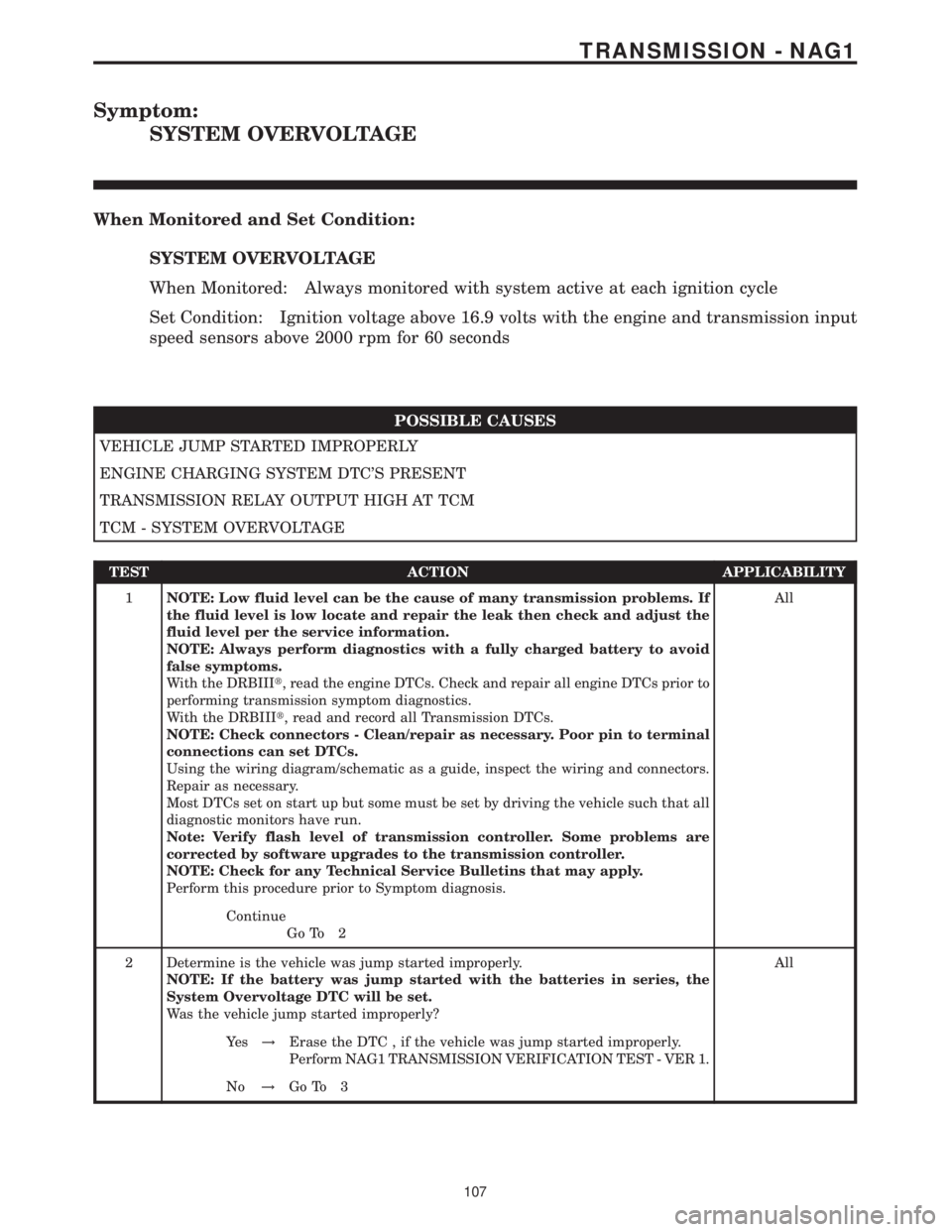
Symptom:
SYSTEM OVERVOLTAGE
When Monitored and Set Condition:
SYSTEM OVERVOLTAGE
When Monitored: Always monitored with system active at each ignition cycle
Set Condition: Ignition voltage above 16.9 volts with the engine and transmission input
speed sensors above 2000 rpm for 60 seconds
POSSIBLE CAUSES
VEHICLE JUMP STARTED IMPROPERLY
ENGINE CHARGING SYSTEM DTC'S PRESENT
TRANSMISSION RELAY OUTPUT HIGH AT TCM
TCM - SYSTEM OVERVOLTAGE
TEST ACTION APPLICABILITY
1NOTE: Low fluid level can be the cause of many transmission problems. If
the fluid level is low locate and repair the leak then check and adjust the
fluid level per the service information.
NOTE: Always perform diagnostics with a fully charged battery to avoid
false symptoms.
With the DRBIIIt, read the engine DTCs. Check and repair all engine DTCs prior to
performing transmission symptom diagnostics.
With the DRBIIIt, read and record all Transmission DTCs.
NOTE: Check connectors - Clean/repair as necessary. Poor pin to terminal
connections can set DTCs.
Using the wiring diagram/schematic as a guide, inspect the wiring and connectors.
Repair as necessary.
Most DTCs set on start up but some must be set by driving the vehicle such that all
diagnostic monitors have run.
Note: Verify flash level of transmission controller. Some problems are
corrected by software upgrades to the transmission controller.
NOTE: Check for any Technical Service Bulletins that may apply.
Perform this procedure prior to Symptom diagnosis.All
Continue
Go To 2
2 Determine is the vehicle was jump started improperly.
NOTE: If the battery was jump started with the batteries in series, the
System Overvoltage DTC will be set.
Was the vehicle jump started improperly?All
Ye s!Erase the DTC , if the vehicle was jump started improperly.
Perform NAG1 TRANSMISSION VERIFICATION TEST - VER 1.
No!Go To 3
107
TRANSMISSION - NAG1
Page 2273 of 2305
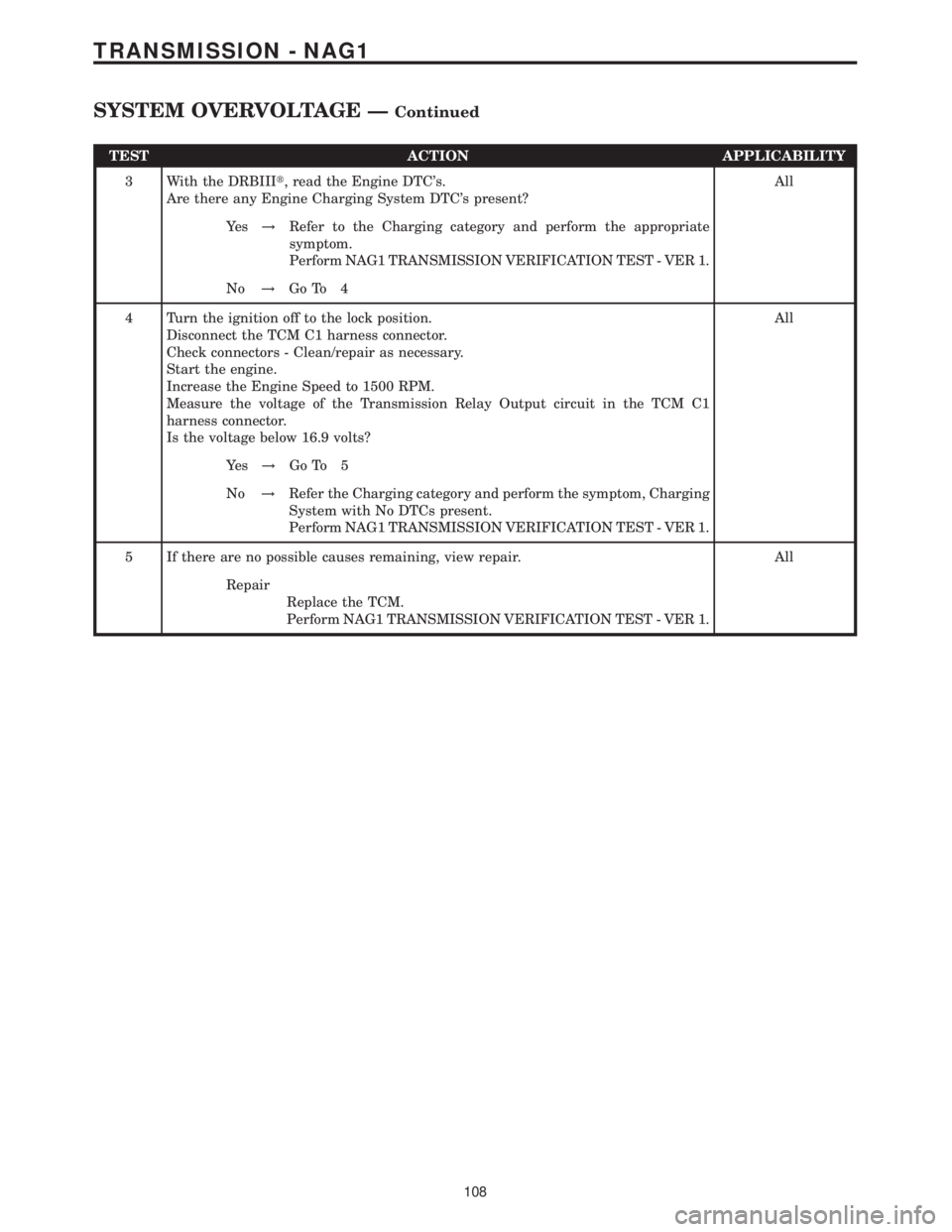
TEST ACTION APPLICABILITY
3 With the DRBIIIt, read the Engine DTC's.
Are there any Engine Charging System DTC's present?All
Ye s!Refer to the Charging category and perform the appropriate
symptom.
Perform NAG1 TRANSMISSION VERIFICATION TEST - VER 1.
No!Go To 4
4 Turn the ignition off to the lock position.
Disconnect the TCM C1 harness connector.
Check connectors - Clean/repair as necessary.
Start the engine.
Increase the Engine Speed to 1500 RPM.
Measure the voltage of the Transmission Relay Output circuit in the TCM C1
harness connector.
Is the voltage below 16.9 volts?All
Ye s!Go To 5
No!Refer the Charging category and perform the symptom, Charging
System with No DTCs present.
Perform NAG1 TRANSMISSION VERIFICATION TEST - VER 1.
5 If there are no possible causes remaining, view repair. All
Repair
Replace the TCM.
Perform NAG1 TRANSMISSION VERIFICATION TEST - VER 1.
108
TRANSMISSION - NAG1
SYSTEM OVERVOLTAGE ÐContinued
Page 2274 of 2305
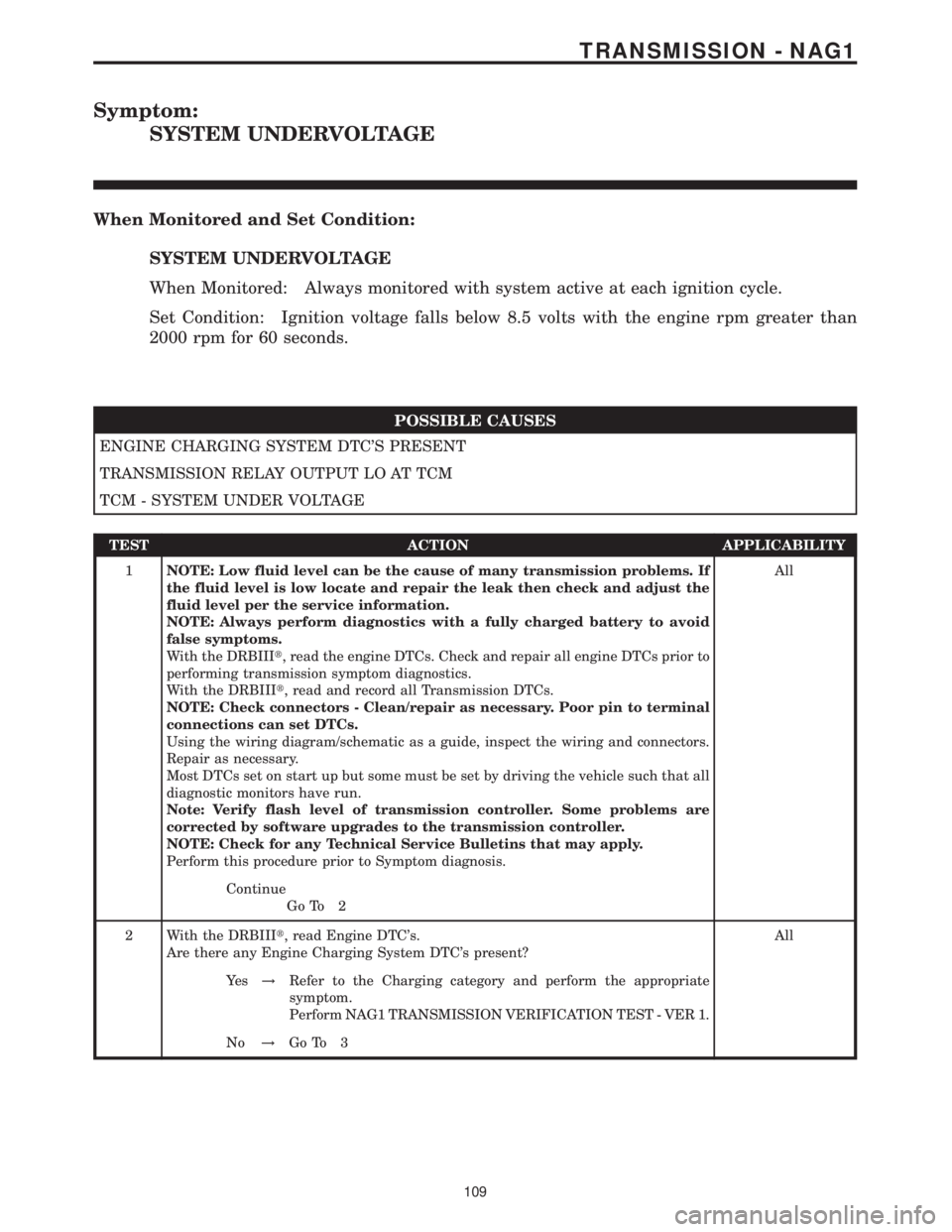
Symptom:
SYSTEM UNDERVOLTAGE
When Monitored and Set Condition:
SYSTEM UNDERVOLTAGE
When Monitored: Always monitored with system active at each ignition cycle.
Set Condition: Ignition voltage falls below 8.5 volts with the engine rpm greater than
2000 rpm for 60 seconds.
POSSIBLE CAUSES
ENGINE CHARGING SYSTEM DTC'S PRESENT
TRANSMISSION RELAY OUTPUT LO AT TCM
TCM - SYSTEM UNDER VOLTAGE
TEST ACTION APPLICABILITY
1NOTE: Low fluid level can be the cause of many transmission problems. If
the fluid level is low locate and repair the leak then check and adjust the
fluid level per the service information.
NOTE: Always perform diagnostics with a fully charged battery to avoid
false symptoms.
With the DRBIIIt, read the engine DTCs. Check and repair all engine DTCs prior to
performing transmission symptom diagnostics.
With the DRBIIIt, read and record all Transmission DTCs.
NOTE: Check connectors - Clean/repair as necessary. Poor pin to terminal
connections can set DTCs.
Using the wiring diagram/schematic as a guide, inspect the wiring and connectors.
Repair as necessary.
Most DTCs set on start up but some must be set by driving the vehicle such that all
diagnostic monitors have run.
Note: Verify flash level of transmission controller. Some problems are
corrected by software upgrades to the transmission controller.
NOTE: Check for any Technical Service Bulletins that may apply.
Perform this procedure prior to Symptom diagnosis.All
Continue
Go To 2
2 With the DRBIIIt, read Engine DTC's.
Are there any Engine Charging System DTC's present?All
Ye s!Refer to the Charging category and perform the appropriate
symptom.
Perform NAG1 TRANSMISSION VERIFICATION TEST - VER 1.
No!Go To 3
109
TRANSMISSION - NAG1
Page 2275 of 2305
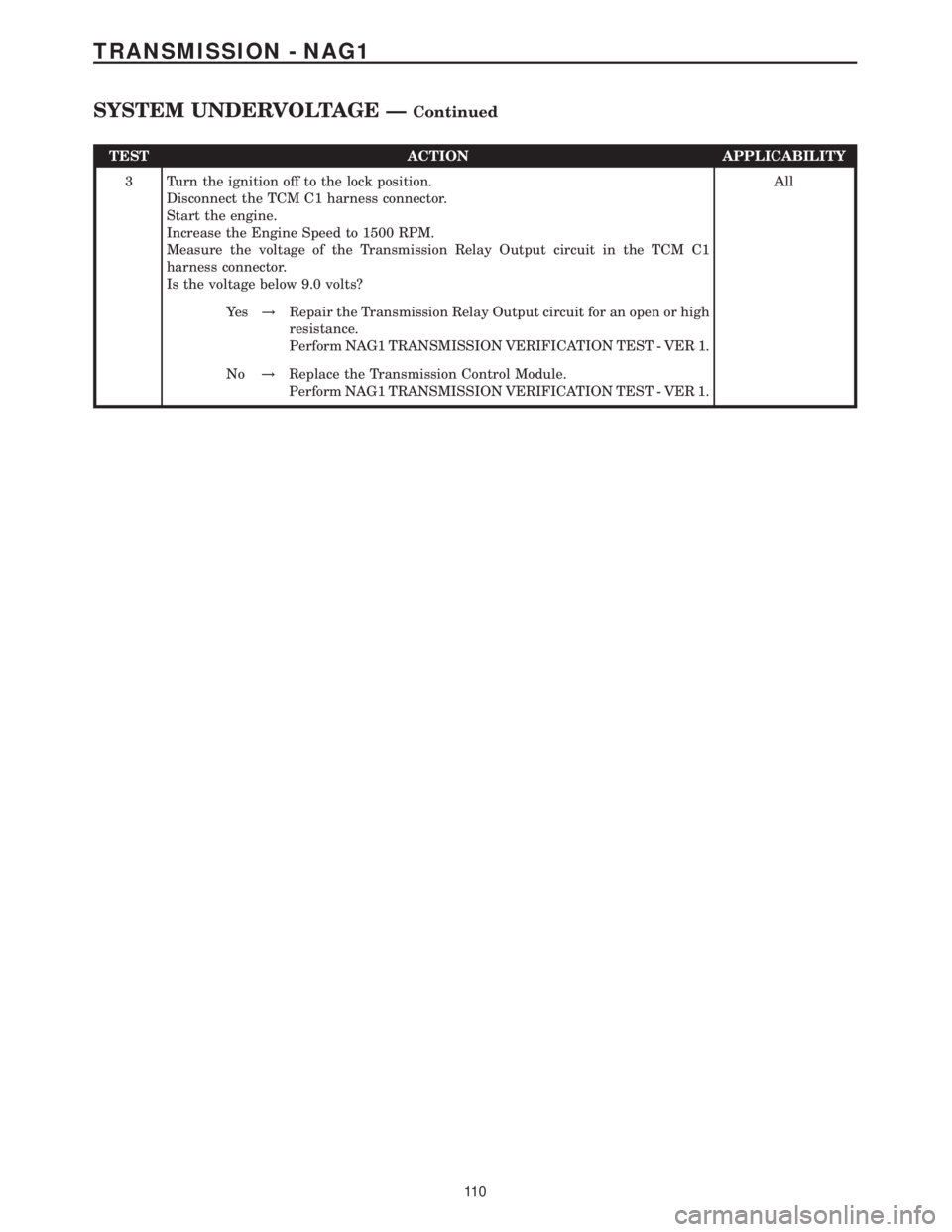
TEST ACTION APPLICABILITY
3 Turn the ignition off to the lock position.
Disconnect the TCM C1 harness connector.
Start the engine.
Increase the Engine Speed to 1500 RPM.
Measure the voltage of the Transmission Relay Output circuit in the TCM C1
harness connector.
Is the voltage below 9.0 volts?All
Ye s!Repair the Transmission Relay Output circuit for an open or high
resistance.
Perform NAG1 TRANSMISSION VERIFICATION TEST - VER 1.
No!Replace the Transmission Control Module.
Perform NAG1 TRANSMISSION VERIFICATION TEST - VER 1.
11 0
TRANSMISSION - NAG1
SYSTEM UNDERVOLTAGE ÐContinued
Page 2276 of 2305
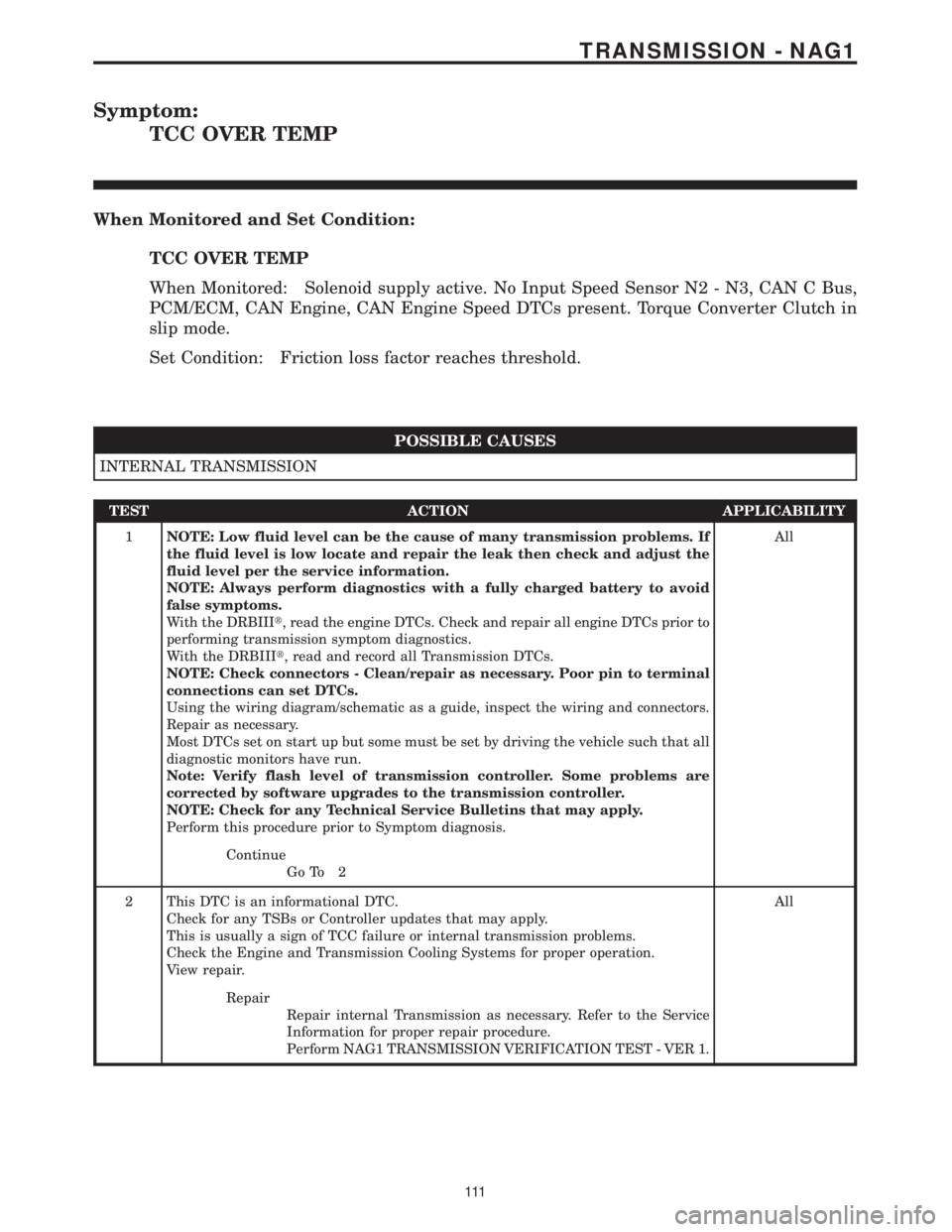
Symptom:
TCC OVER TEMP
When Monitored and Set Condition:
TCC OVER TEMP
When Monitored: Solenoid supply active. No Input Speed Sensor N2 - N3, CAN C Bus,
PCM/ECM, CAN Engine, CAN Engine Speed DTCs present. Torque Converter Clutch in
slip mode.
Set Condition: Friction loss factor reaches threshold.
POSSIBLE CAUSES
INTERNAL TRANSMISSION
TEST ACTION APPLICABILITY
1NOTE: Low fluid level can be the cause of many transmission problems. If
the fluid level is low locate and repair the leak then check and adjust the
fluid level per the service information.
NOTE: Always perform diagnostics with a fully charged battery to avoid
false symptoms.
With the DRBIIIt, read the engine DTCs. Check and repair all engine DTCs prior to
performing transmission symptom diagnostics.
With the DRBIIIt, read and record all Transmission DTCs.
NOTE: Check connectors - Clean/repair as necessary. Poor pin to terminal
connections can set DTCs.
Using the wiring diagram/schematic as a guide, inspect the wiring and connectors.
Repair as necessary.
Most DTCs set on start up but some must be set by driving the vehicle such that all
diagnostic monitors have run.
Note: Verify flash level of transmission controller. Some problems are
corrected by software upgrades to the transmission controller.
NOTE: Check for any Technical Service Bulletins that may apply.
Perform this procedure prior to Symptom diagnosis.All
Continue
Go To 2
2 This DTC is an informational DTC.
Check for any TSBs or Controller updates that may apply.
This is usually a sign of TCC failure or internal transmission problems.
Check the Engine and Transmission Cooling Systems for proper operation.
View repair.All
Repair
Repair internal Transmission as necessary. Refer to the Service
Information for proper repair procedure.
Perform NAG1 TRANSMISSION VERIFICATION TEST - VER 1.
111
TRANSMISSION - NAG1
Page 2277 of 2305
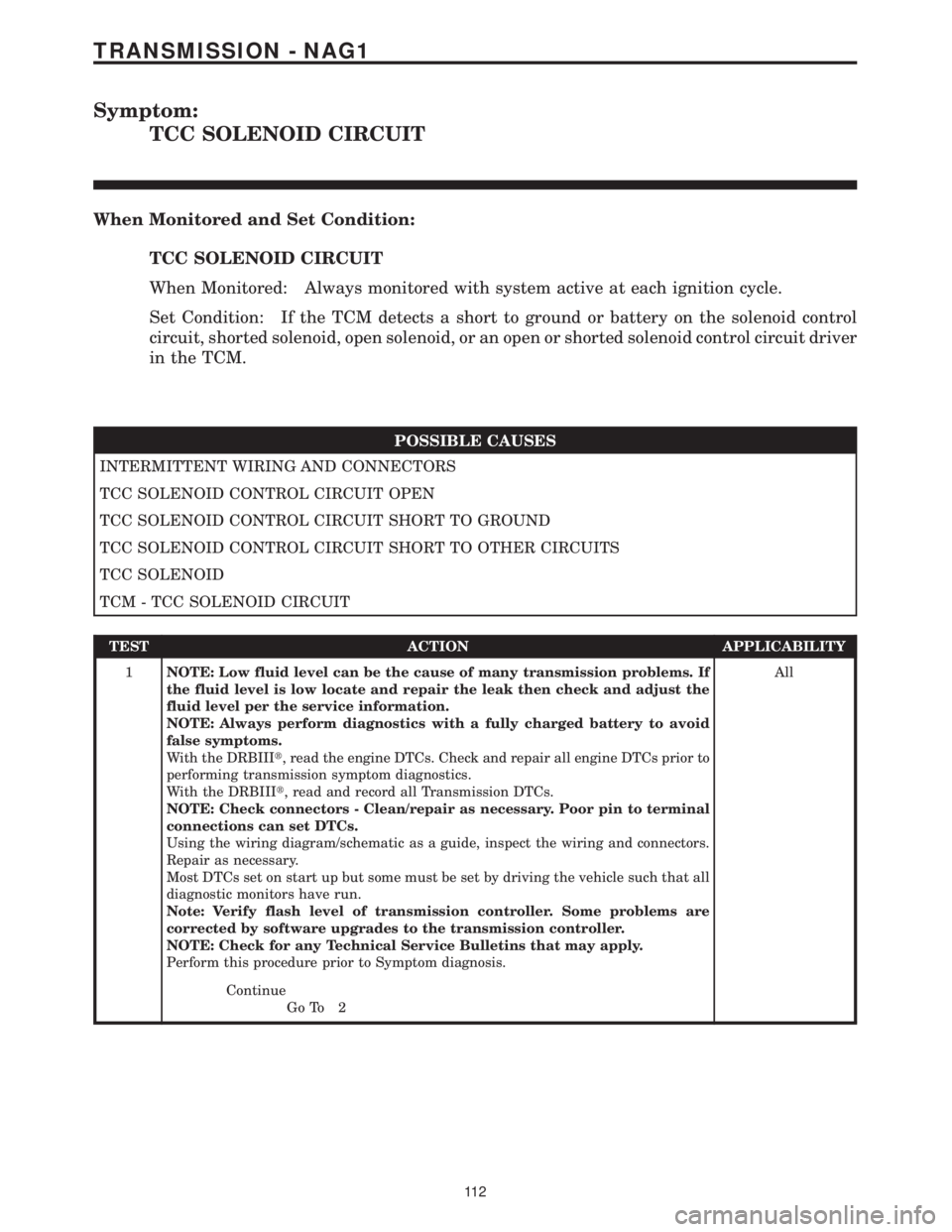
Symptom:
TCC SOLENOID CIRCUIT
When Monitored and Set Condition:
TCC SOLENOID CIRCUIT
When Monitored: Always monitored with system active at each ignition cycle.
Set Condition: If the TCM detects a short to ground or battery on the solenoid control
circuit, shorted solenoid, open solenoid, or an open or shorted solenoid control circuit driver
in the TCM.
POSSIBLE CAUSES
INTERMITTENT WIRING AND CONNECTORS
TCC SOLENOID CONTROL CIRCUIT OPEN
TCC SOLENOID CONTROL CIRCUIT SHORT TO GROUND
TCC SOLENOID CONTROL CIRCUIT SHORT TO OTHER CIRCUITS
TCC SOLENOID
TCM - TCC SOLENOID CIRCUIT
TEST ACTION APPLICABILITY
1NOTE: Low fluid level can be the cause of many transmission problems. If
the fluid level is low locate and repair the leak then check and adjust the
fluid level per the service information.
NOTE: Always perform diagnostics with a fully charged battery to avoid
false symptoms.
With the DRBIIIt, read the engine DTCs. Check and repair all engine DTCs prior to
performing transmission symptom diagnostics.
With the DRBIIIt, read and record all Transmission DTCs.
NOTE: Check connectors - Clean/repair as necessary. Poor pin to terminal
connections can set DTCs.
Using the wiring diagram/schematic as a guide, inspect the wiring and connectors.
Repair as necessary.
Most DTCs set on start up but some must be set by driving the vehicle such that all
diagnostic monitors have run.
Note: Verify flash level of transmission controller. Some problems are
corrected by software upgrades to the transmission controller.
NOTE: Check for any Technical Service Bulletins that may apply.
Perform this procedure prior to Symptom diagnosis.All
Continue
Go To 2
11 2
TRANSMISSION - NAG1
Page 2278 of 2305
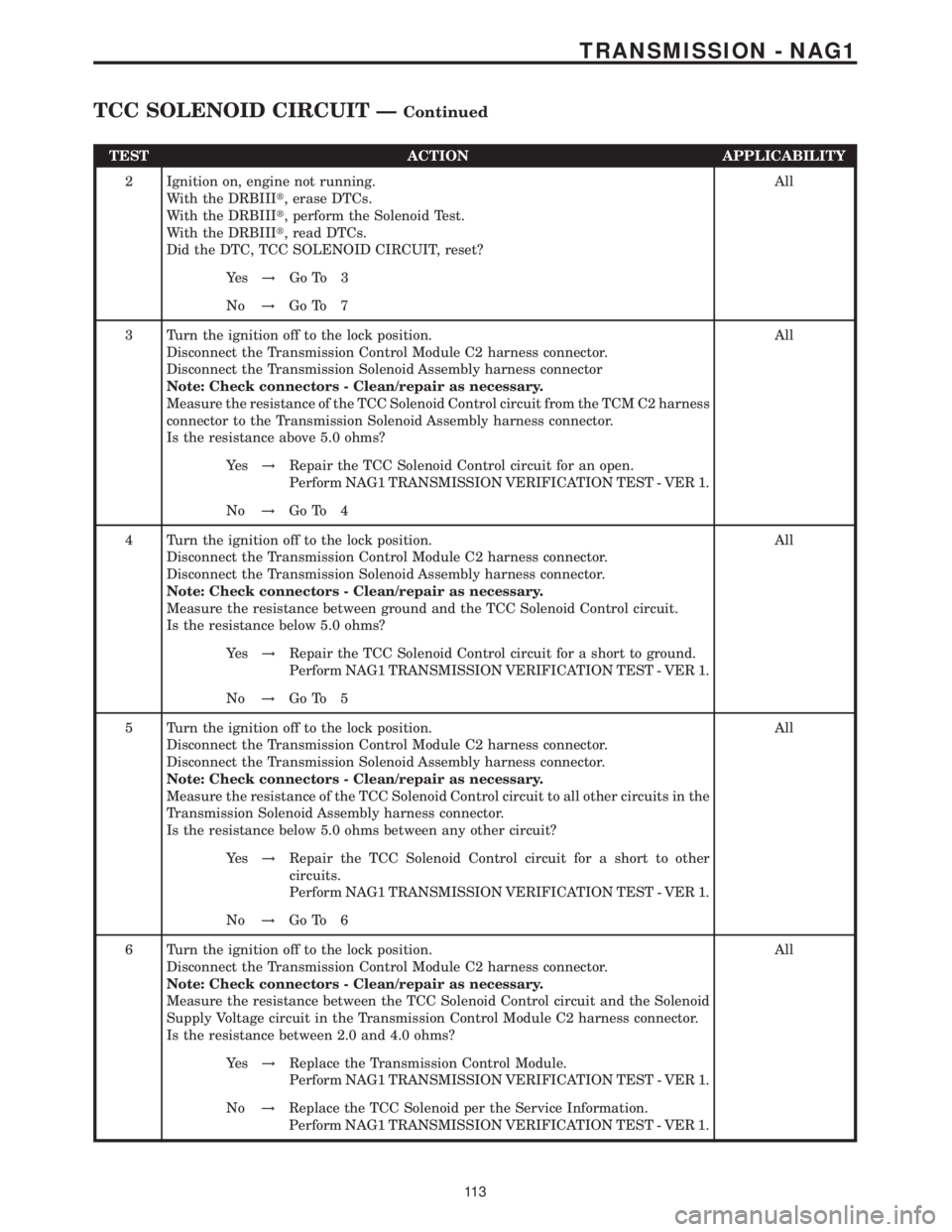
TEST ACTION APPLICABILITY
2 Ignition on, engine not running.
With the DRBIIIt, erase DTCs.
With the DRBIIIt, perform the Solenoid Test.
With the DRBIIIt, read DTCs.
Did the DTC, TCC SOLENOID CIRCUIT, reset?All
Ye s!Go To 3
No!Go To 7
3 Turn the ignition off to the lock position.
Disconnect the Transmission Control Module C2 harness connector.
Disconnect the Transmission Solenoid Assembly harness connector
Note: Check connectors - Clean/repair as necessary.
Measure the resistance of the TCC Solenoid Control circuit from the TCM C2 harness
connector to the Transmission Solenoid Assembly harness connector.
Is the resistance above 5.0 ohms?All
Ye s!Repair the TCC Solenoid Control circuit for an open.
Perform NAG1 TRANSMISSION VERIFICATION TEST - VER 1.
No!Go To 4
4 Turn the ignition off to the lock position.
Disconnect the Transmission Control Module C2 harness connector.
Disconnect the Transmission Solenoid Assembly harness connector.
Note: Check connectors - Clean/repair as necessary.
Measure the resistance between ground and the TCC Solenoid Control circuit.
Is the resistance below 5.0 ohms?All
Ye s!Repair the TCC Solenoid Control circuit for a short to ground.
Perform NAG1 TRANSMISSION VERIFICATION TEST - VER 1.
No!Go To 5
5 Turn the ignition off to the lock position.
Disconnect the Transmission Control Module C2 harness connector.
Disconnect the Transmission Solenoid Assembly harness connector.
Note: Check connectors - Clean/repair as necessary.
Measure the resistance of the TCC Solenoid Control circuit to all other circuits in the
Transmission Solenoid Assembly harness connector.
Is the resistance below 5.0 ohms between any other circuit?All
Ye s!Repair the TCC Solenoid Control circuit for a short to other
circuits.
Perform NAG1 TRANSMISSION VERIFICATION TEST - VER 1.
No!Go To 6
6 Turn the ignition off to the lock position.
Disconnect the Transmission Control Module C2 harness connector.
Note: Check connectors - Clean/repair as necessary.
Measure the resistance between the TCC Solenoid Control circuit and the Solenoid
Supply Voltage circuit in the Transmission Control Module C2 harness connector.
Is the resistance between 2.0 and 4.0 ohms?All
Ye s!Replace the Transmission Control Module.
Perform NAG1 TRANSMISSION VERIFICATION TEST - VER 1.
No!Replace the TCC Solenoid per the Service Information.
Perform NAG1 TRANSMISSION VERIFICATION TEST - VER 1.
11 3
TRANSMISSION - NAG1
TCC SOLENOID CIRCUIT ÐContinued
Page 2279 of 2305
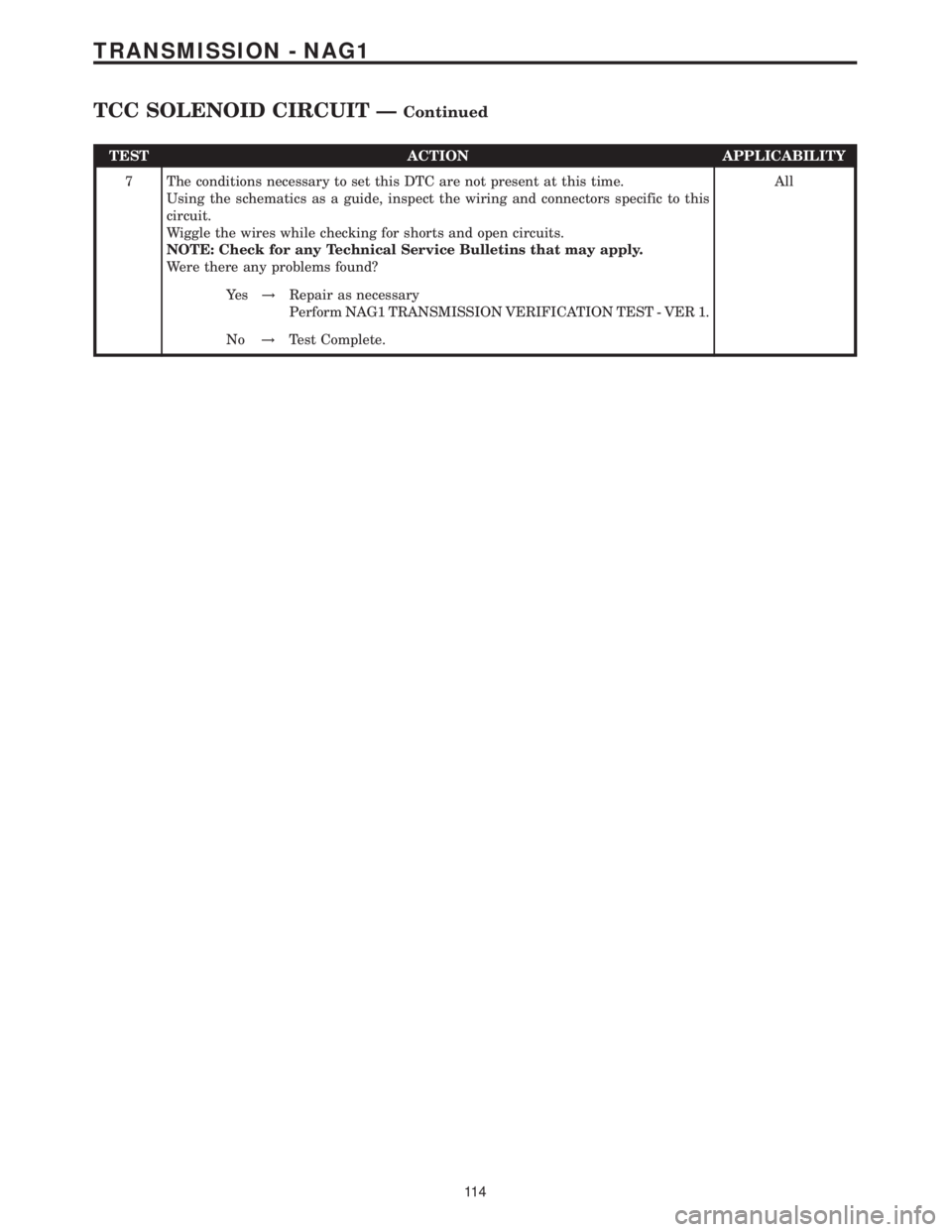
TEST ACTION APPLICABILITY
7 The conditions necessary to set this DTC are not present at this time.
Using the schematics as a guide, inspect the wiring and connectors specific to this
circuit.
Wiggle the wires while checking for shorts and open circuits.
NOTE: Check for any Technical Service Bulletins that may apply.
Were there any problems found?All
Ye s!Repair as necessary
Perform NAG1 TRANSMISSION VERIFICATION TEST - VER 1.
No!Test Complete.
11 4
TRANSMISSION - NAG1
TCC SOLENOID CIRCUIT ÐContinued
Page 2280 of 2305
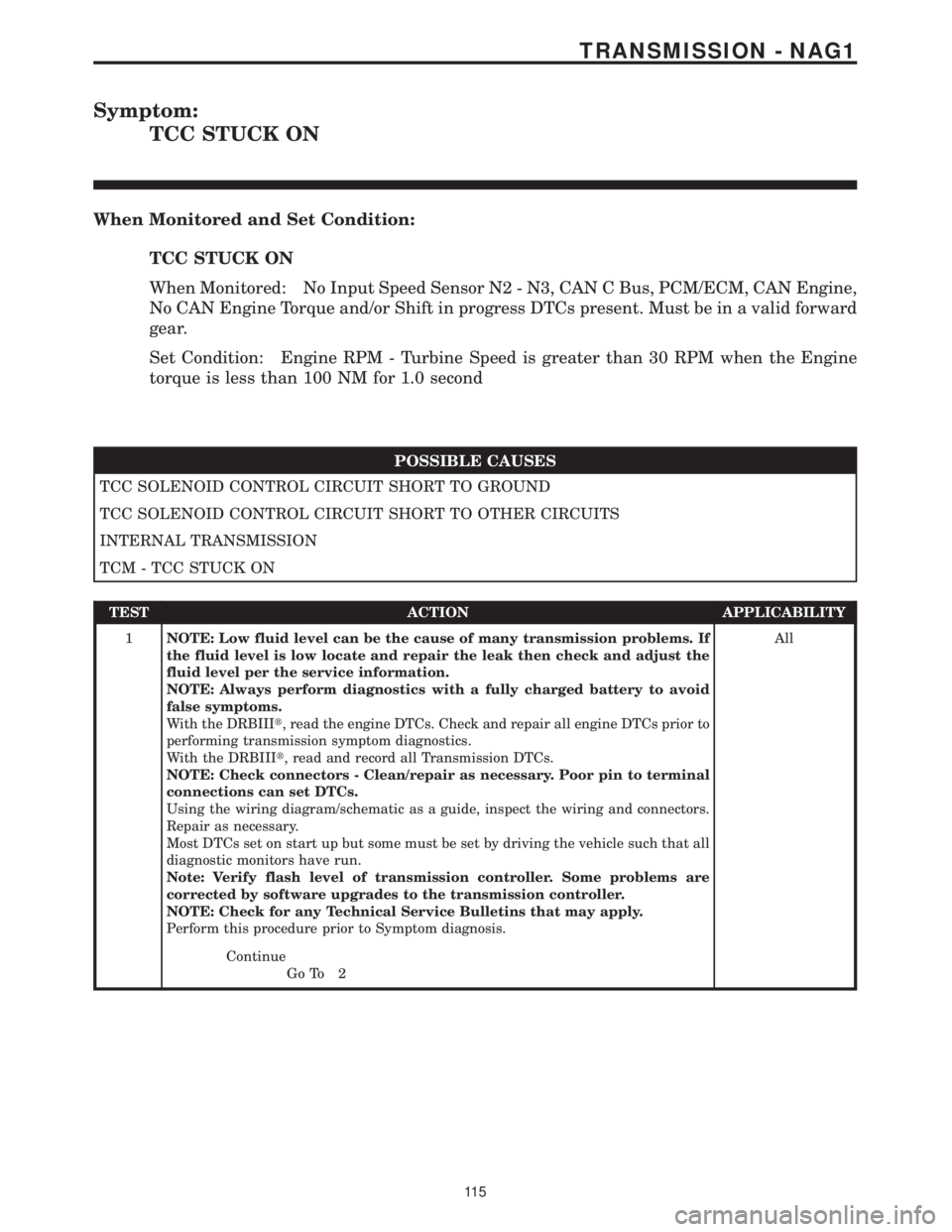
Symptom:
TCC STUCK ON
When Monitored and Set Condition:
TCC STUCK ON
When Monitored: No Input Speed Sensor N2 - N3, CAN C Bus, PCM/ECM, CAN Engine,
No CAN Engine Torque and/or Shift in progress DTCs present. Must be in a valid forward
gear.
Set Condition: Engine RPM - Turbine Speed is greater than 30 RPM when the Engine
torque is less than 100 NM for 1.0 second
POSSIBLE CAUSES
TCC SOLENOID CONTROL CIRCUIT SHORT TO GROUND
TCC SOLENOID CONTROL CIRCUIT SHORT TO OTHER CIRCUITS
INTERNAL TRANSMISSION
TCM - TCC STUCK ON
TEST ACTION APPLICABILITY
1NOTE: Low fluid level can be the cause of many transmission problems. If
the fluid level is low locate and repair the leak then check and adjust the
fluid level per the service information.
NOTE: Always perform diagnostics with a fully charged battery to avoid
false symptoms.
With the DRBIIIt, read the engine DTCs. Check and repair all engine DTCs prior to
performing transmission symptom diagnostics.
With the DRBIIIt, read and record all Transmission DTCs.
NOTE: Check connectors - Clean/repair as necessary. Poor pin to terminal
connections can set DTCs.
Using the wiring diagram/schematic as a guide, inspect the wiring and connectors.
Repair as necessary.
Most DTCs set on start up but some must be set by driving the vehicle such that all
diagnostic monitors have run.
Note: Verify flash level of transmission controller. Some problems are
corrected by software upgrades to the transmission controller.
NOTE: Check for any Technical Service Bulletins that may apply.
Perform this procedure prior to Symptom diagnosis.All
Continue
Go To 2
11 5
TRANSMISSION - NAG1